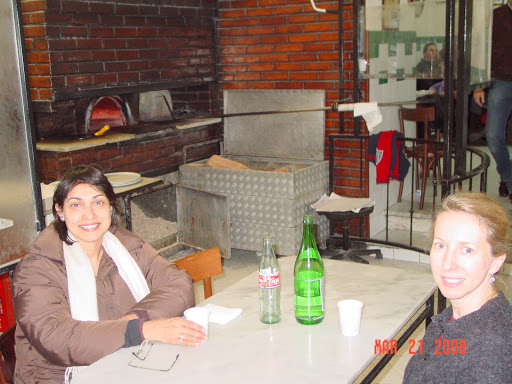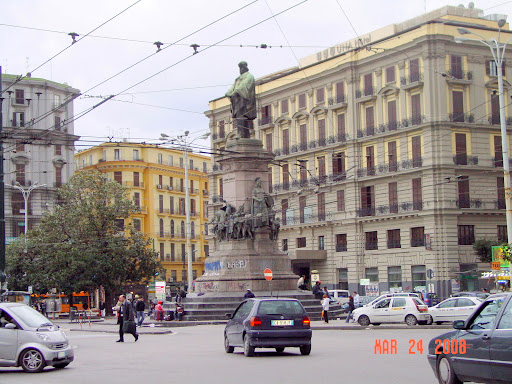(Piazza Garibaldi is a busy square right outside the Main Railway Station in Naples)
Viewing the Spectacular Tuscan Countryside:
The best part about Naples is getting there—on the train from Florence, we passed by the most picturesque Tuscan countryside that reminded me instantly of the visuals conjured up by my reading of Frances Mayes’ books Under the Tuscan Sun and Bella Tuscany. Not surprisingly, we passed through the environs of Cortona, the village she immortalized in her books. There was fresh spring green outside my window that made it impossible for me to take my eyes off the landscape for even a second. Yellow and orange were the dominant colors of the homes we saw, many perched precariously on the very ledge of hillside promontories. Sheep dotted the fields and orange groves were in full fruit as we trundled towards Rome where the suburbs seemed like eyesores after the beauty of the countryside.
After Florence, Naples came at me like a rude shock. From the moment one walks out of the train station into Piazza Garibaldi—an ugly square surrounded by squat buildings–the decrepit nature of the city assaults. Never having made any apologies for itself, Naples wears its ugliness proudly, almost having made a visual icon of its clothes that hang out to dry from cluttered balconies and the heaps of garbage that clog its streets. In recent years, the city has become inundated with the human detritus of natural and man-made disasters. Casualties of that fall-out from Sri Lanka’s tsunami to the ethnic conflicts in Rwanda and Zimbabwe have brought droves of illegal immigrants who make a precarious living as waiters in the city’s eateries and on the streets where they sell knock-off designer handbags from out of giant blue plastic bags. There is nothing even remotely touristy about Naples, probably because most visitors merely use it as a transit point for their forays into the chic enclaves of Capri and Sorrento, Pompeii and Herculaneum.
But, having made our own base in Naples, for the next three days, we decided to explore its most significant monuments. Stashing our bags in the Hotel Bonapace, very conveniently located just behind the Porta Nolana Station which is the place from which the Circumvesuviana train runs along the Bay of Naples, we went out to get ourselves some lunch. Amy had read Elizabeth Gilbert’s book Eat, Pray, Love and remembered a pizzeria about which the author had raved. Located right off Corso Umberto, just a ten minute walk from our hotel, we found Antica Pizzeria da Michele which serves the best pizza in Naples, the very place where pizza was invented. There was a queue waiting outside the restaurant but because we were just two (as opposed to the groups of five and six that arrived in single parties), we were ushered inside and seated at a marble topped table right in front of the brick ovens from which the pizzas emerged.
 This place (left) serves only one kind of Pizza—Pizza Margherita–which is simply tomato sauce, mozzarella cheese and basil. And how completely delicious it was is hard to describe! There were many things we realized about pizza during that first meal in Naples. First of all, pizza is NOT fast food in Italy. You sit down and eat it with a fork and knife. Secondly, you do not share a pie with other members at your table. Each diner orders an entire pie and eats it alone. Thirdly, the pizza has a very thin, almost crunchy crust. Fourthly, it is served with no condiments, no fuss. There is no garlic powder, oregano, pepper flakes or parmesan cheese as we see on American tables. Just remarkably good pizza. Washed down with chilled Cokes (my favorite drink when eating pizza), it made a memorable meal indeed and we were so glad we chose to eat our first meal in Naples at this place because for the rest of the weekend (it being the long Easter weekend), the restaurant remained firmly closed. Having been a family business since the late 1800s, da Michele is run without an eye to massive profits and despite the fact that tourists have discovered it (thanks to Gilbert and Lonely Planet), a whole pie still costs only 4 Euros.
This place (left) serves only one kind of Pizza—Pizza Margherita–which is simply tomato sauce, mozzarella cheese and basil. And how completely delicious it was is hard to describe! There were many things we realized about pizza during that first meal in Naples. First of all, pizza is NOT fast food in Italy. You sit down and eat it with a fork and knife. Secondly, you do not share a pie with other members at your table. Each diner orders an entire pie and eats it alone. Thirdly, the pizza has a very thin, almost crunchy crust. Fourthly, it is served with no condiments, no fuss. There is no garlic powder, oregano, pepper flakes or parmesan cheese as we see on American tables. Just remarkably good pizza. Washed down with chilled Cokes (my favorite drink when eating pizza), it made a memorable meal indeed and we were so glad we chose to eat our first meal in Naples at this place because for the rest of the weekend (it being the long Easter weekend), the restaurant remained firmly closed. Having been a family business since the late 1800s, da Michele is run without an eye to massive profits and despite the fact that tourists have discovered it (thanks to Gilbert and Lonely Planet), a whole pie still costs only 4 Euros.
Then, we were at the Piazza Garibaldi station again, taking an underground train to Piazza Cavour with the aim of exploring the Museo Archeologico Nazionale (National Archeological Museum). This stupendous building houses a collection that is one of Europe’s most significant—the excavated remains of the cities of Pompeii, Herculaneum and Castellamara del Stabia. The guide books are absolutely right when they state that the museum is overwhelming. The entry fee (a steep 10 Euros) permits a glimpse into so vast a civilization that one can only focus on the few objects that are considered its highlights—and that was what we did.
 So we trooped off, first of all, to see the Farnese Bull (left) that was a remake of the original found in the Roman Baths at Carracala. It is a monumental piece of work and towers above the viewer. Portraying the Torture of Dirce by Amphion and Zethus by tying her to the horns of a bull, it is almost savage in its depiction of the myth. Next, we caught a glimpse of a huge figure of Hercules, though it was concealed behind a curtain undergoing renovation. Napoleon is said to have been sorry that he was unable to take this sculpture with him during his plundering of Italy’s art works. On another floor, we saw the superb original mosaic depicting the Battle of Alexander the Great against King Darius of Persia, which was found in the House of the Fawn in Pompeii. I found the helmet of a Roman gladiator extraordinarily moving for somehow it seemed to bring home to me with an inexplicable immediacy the fact that such bloody sports did, in fact, excite ancient Romans and that so many young men were brutally killed in their arenas. In the glass section, both Amy and I who love glass, were deeply taken by the Blue Vase, a cameo-like work in deep cobalt blue and white that survived intact after the volcanic eruption that decimated Pompeii. I am certain that we would have enjoyed the museum much more, were we able to read the labels that were in Italian only.
So we trooped off, first of all, to see the Farnese Bull (left) that was a remake of the original found in the Roman Baths at Carracala. It is a monumental piece of work and towers above the viewer. Portraying the Torture of Dirce by Amphion and Zethus by tying her to the horns of a bull, it is almost savage in its depiction of the myth. Next, we caught a glimpse of a huge figure of Hercules, though it was concealed behind a curtain undergoing renovation. Napoleon is said to have been sorry that he was unable to take this sculpture with him during his plundering of Italy’s art works. On another floor, we saw the superb original mosaic depicting the Battle of Alexander the Great against King Darius of Persia, which was found in the House of the Fawn in Pompeii. I found the helmet of a Roman gladiator extraordinarily moving for somehow it seemed to bring home to me with an inexplicable immediacy the fact that such bloody sports did, in fact, excite ancient Romans and that so many young men were brutally killed in their arenas. In the glass section, both Amy and I who love glass, were deeply taken by the Blue Vase, a cameo-like work in deep cobalt blue and white that survived intact after the volcanic eruption that decimated Pompeii. I am certain that we would have enjoyed the museum much more, were we able to read the labels that were in Italian only.
The next stop on our agenda was a church—since it was Good Friday, I was keen on attending an evening service and in the city’s Duomo de San Gennaro (main Church in a city that is strewn with them), I felt fortunate to catch a service featuring the Cardinal of Naples in full regalia with a huge entourage of priests in a concelebrated service that featured the Veneration of the Cross and Holy Communion. This service took place in the ornate church whose altar was heavily gilded. I was able to peak into the side Chapel of San Gennaro which contains many relics of this revered saint of the Italian South—phials of his blood are said to liquefy once a year and his head is enclosed within a silver-gilt bust. The atmosphere in the church was deeply solemn on this holiest of days and I felt privileged to be in its presence as the priests trooped out.
Then, I was ready to break my Good Friday fast with dinner at a pizzeria and this time round we chose Pizzeria Trianon which is located just one street behind the more famous da Michele. However, we found Trianon’s Marinara Pizza with extra Mozarella just as good if not better than the one we had devoured that afternoon. Amy and I always split a pizza as we found it impossible to eat a whole one by ourselves.
Overall, Naples reminded me so much of Bombay. The chaos of the city, the loudly blaring horns, the traffic choking the streets, the combination in the air of neglect and homeliness is hard to describe. Visions of my hometown kept coming back to me as I fell asleep exhausted that night.
(To Follow Amy and me on the next leg of our travels in Pompei, Italy, please click on the link below:)
Bon Voyage!
